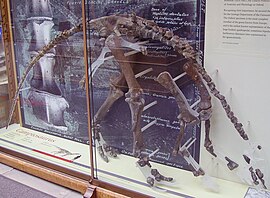Cumnoria
Stratigrafický výskyt: Svrchní jura, asi před 153 miliony let | |
|---|---|
 Zachovaná část kostry v muzejní expozici. | |
| Vědecká klasifikace | |
| Říše | živočichové (Animalia) |
| Kmen | strunatci (Chordata) |
| Třída | plazi (Sauropsida) |
| Nadřád | dinosauři (Dinosauria) |
| Řád | ptakopánví (Ornithischia) |
| Podřád | Cerapoda |
| Infrařád | Ornithopoda |
| Rod | Cumnoria Seeley, 1888 |
| Binomické jméno | |
| Cumnoria prestwichi Hulke, 1880 | |
| Některá data mohou pocházet z datové položky. | |
Cumnoria („ze vsi Cumnor“) byl rod menšího iguanodontního ornitopodního dinosaura, žijícího v období svrchní jury (věk kimmeridž, před 157 až 152 miliony let) na území dnešní Velké Británie (hrabství Oxfordshire).[1]
Historie
[editovat | editovat zdroj]
Fosilie tohoto ornitopoda (holotyp nese označení OXFUM J.3303) byly objeveny dělníky v lomu Chawley Brick Pits v obci Cumnor několik kilometrů od Oxfordu, a to v sedimentech souvrství Kimmeridge Clay. V roce 1879 se dostaly do rukou profesora anatomie George Rollestona a následně paleontologa Josepha Prestwiche, který o nich poprvé pojednal v odborné literatuře.[2] Původně byl tak tento taxon roku 1880 popsán jako Iguanodon prestwichi, později však Harry Govier Seeley změnil rodové jméno na Cumnoria, podle obce Cumnor, v níž byly fosilie dinosaura objeveny.[3][4] Jen o rok později však další britský paleontolog Richard Lydekker zahrnul tento taxon do rodu Camptosaurus.[5] Tento názor byl poté uznáván více než století. Až další výzkum z roku 1998 ukázal, že se ve skutečnosti jedná o samostatný rod a bylo tedy znovu stanoveno jméno Cumnoria prestwichi.[6] Dnes je tento rod řazen do kladu Styracosterna.[7]
Popis a zařazení
[editovat | editovat zdroj]Cumnoria byl menší rod iguanodontního ornitopoda, dosahující délky kolem 5 metrů a hmotnosti v řádu stovek kilogramů[8] Vzhledem k tomu, že je znám pouze juvenilní exemplář o délce kolem 3,5 metru, přesná dospělá velikost není známá.[9] Blízce příbuzným druhem tohoto styrakosterna je například severoamerický taxon Uteodon aphanoecetes z Utahu.[10]
Odkazy
[editovat | editovat zdroj]Reference
[editovat | editovat zdroj]- ↑ Susannah C. R. Maidment, Kimberley E. J. Chapelle, Joseph A. Bonsor, David Button & Paul M. Barrett (2022) [2023]. Osteology and relationships of Cumnoria prestwichii (Ornithischia: Ornithopoda) from the Late Jurassic of Oxfordshire, UK. Monographs of the Palaeontographical Society. 176 (664): 1-55. doi: https://doi.org/10.1080/02693445.2022.2162669
- ↑ Prestwich, J. (1879). "On the discovery of a species of Iguanodon in the Kimmeridge Clay near Oxford; and a notice of a very fossiliferous band of the Shotover Sands". Geological Magazine, New Series, Decade 2. 6 (5): 193–195. doi: 10.1017/s0016756800157000
- ↑ Hulke, J. W. (1880). "Iguanodon prestwichii, a new species from the Kimmeridge Clay, distinguished from I. mantelli of the Wealden Formation in the S.E. of England and Isle of Wight by differences in the shape of the vertebral centra, by fewer than five sacral vertebrae, by the simpler character of its tooth-serrature, etc., founded on numerous fossil remains lately discovered at Cumnor, near Oxford". Quarterly Journal of the Geological Society of London. 36 (143): 433–456. doi: 10.1144/GSL.JGS.1880.036.01-04.36
- ↑ Seeley, H. G. (1888). "On Cumnoria, an iguanodont genus founded upon the Iguanodon prestwichi, Hulke". Report of the British Association for the Advancement of Science. 57: 698.
- ↑ Lydekker, R. (1889). "On the remains and affinities of five genera of Mesozoic reptiles". Quarterly Journal of the Geological Society. 45 (1–4): 41–59. doi: 10.1144/GSL.JGS.1889.045.01-04.04
- ↑ Norman, D. (1998). "On Asian ornithopods (Dinosauria: Ornithischia). 3. A new species of iguanodontid dinosaur". Zoological Journal of the Linnean Society. 122 (1–2): 291–348. doi: 10.1111/j.1096-3642.1998.tb02533.x
- ↑ Andrew T. McDonald (2011). "The taxonomy of species assigned to Camptosaurus (Dinosauria: Ornithopoda)". Zootaxa. 2783: 52–68. doi: 10.11646/zootaxa.2783.1.4
- ↑ Holtz, Thomas R., Jr.; Rey, Luis V. (2007). Dinosaurs: The Most Complete, Up-to-Date Encyclopedia for Dinosaur Lovers of All Ages (Aktualizovaný internetový dodatek, str. 44). New York: Random House. ISBN 978-0-375-82419-7.
- ↑ Paul, G. S. (2016). The Princeton Field Guide to Dinosaurs (2nd Edition). Princeton University Press, str. 316 (anglicky)
- ↑ Carpenter, K.; Wilson, Y. (2008). "A New Species of Camptosaurus (Ornithopoda: Dinosauria) from the Morrison Formation (Upper Jurassic) of Dinosaur National Monument, Utah, and a Biomechanical Analysis of Its Forelimb". Annals of Carnegie Museum. 76 (4): 227. doi: 10.2992/0097-4463(2008)76[227:ANSOCO]2.0.CO;2
Literatura
[editovat | editovat zdroj]- Galton, P. M.; Powell, H. P. (1980). "The ornithischian dinosaur Camptosaurus prestwichii from the Upper Jurassic of England". Palaeontology. 23: 411–443.
- Norman, David B. (2004). "Basal Iguanodontia". in Weishampel, D.B., Dodson, P., and Osmólska, H. (eds.). The Dinosauria (2nd ed.). Berkeley: University of California Press. pp. 413–437. ISBN 0-520-24209-2.
- Paul, Gregory S. (2008). "A revised taxonomy of the iguanodont dinosaur genera and species". Cretaceous Research 29 (2): 192–216. doi:10.1016/j.cretres.2007.04.009.
Externí odkazy
[editovat | editovat zdroj] Obrázky, zvuky či videa k tématu Cumnoria na Wikimedia Commons
Obrázky, zvuky či videa k tématu Cumnoria na Wikimedia Commons - Informace na webu Prehistoric Wildlife (anglicky)
- Informace na webu DinoData (německy)
- Informace na webu DinoChecker (anglicky)
- Profil na databázi Fossilworks Archivováno 9. 6. 2020 na Wayback Machine. (anglicky)